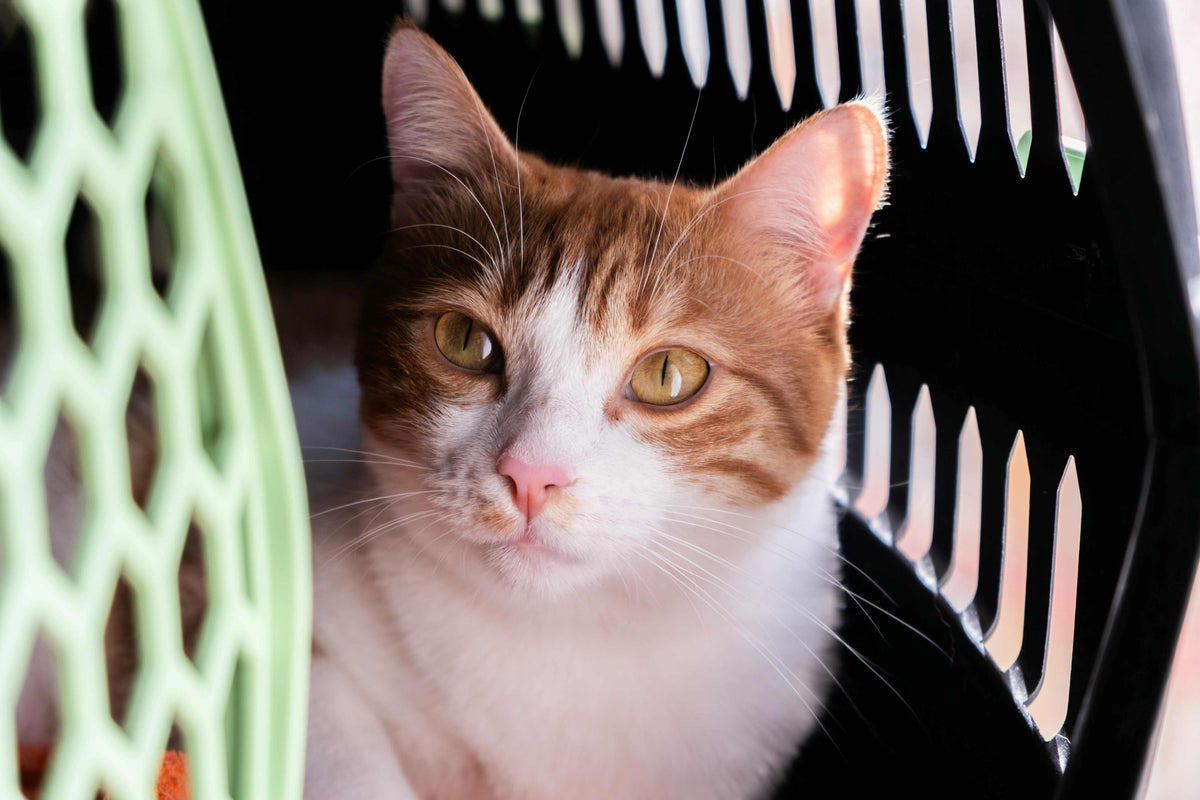

Traveling with your cat isn’t exactly a walk in the park—unless, of course, you’re carrying them through a parking lot into the vet’s office while they yowl like you’ve betrayed them. Whether it’s for routine checkups or an unexpected health issue, vet visits are one of the most common (and most dreaded) travel experiences for cats. Fortunately, a few simple changes can make these trips far more bearable—for both of you.
This guide from LoftyLoo walks you through practical, cat travel tips for stress-free vet visits to prep your cat before, during, and after travel, so your next vet visit doesn’t feel like a full-blown meltdown.
Why Cats Hate Carriers and Car Rides
Let’s be honest: from your cat’s perspective, the carrier is a prison and the car is a spaceship. They associate the carrier with stress, unfamiliar environments, and usually a needle or two at the end of it.
Here’s what adds to the anxiety:
Sudden changes in routine
Confined space in a noisy, shaky environment
Strange smells and sounds
Lack of control
Understanding these triggers can help you address them and create a more comforting experience for your cat. These LoftyLoo cat travel tips for stress-free vet visits can make all the difference.

Cat Travel Tips for Stress-Free Vet Visits Start at Home
A successful trip starts long before you leave the house. Cats are creatures of habit, and any break in routine—like a surprise vet visit—can send them into full meltdown mode. That’s why setting the tone in advance is essential. A smooth vet visit begins with thoughtful, low-stress prep:
Desensitize the Carrier: Leave the carrier out at all times with a cozy blanket and treats inside so it becomes part of your cat’s daily environment. Toss in a favorite toy, and let them nap or snack inside when they feel like it. The goal is to make the carrier feel like a safe, everyday space—not a torture box on wheels.
Practice Short Rides: Take quick drives that don’t end at the vet so your cat doesn’t associate every trip with trauma. Even a loop around the block followed by a treat at home can help reduce their anxiety over time.
Pheromone Sprays: Products like Feliway can help calm your cat when sprayed in the carrier. Use it 15–30 minutes before travel so the effects have time to settle in.
Choose the Right Carrier: Opt for a hard-sided or soft carrier with good ventilation and easy top access. Bonus points if it’s roomy enough for your cat to turn around comfortably.
Cover the Carrier: A towel or light blanket draped over the top helps block overstimulation from sights and sounds. Think of it as a do-not-disturb sign for your feline traveler.
Stay Calm Yourself: Cats mirror your energy. If you’re frazzled and rushing out the door, your cat will pick up on it. Give yourself plenty of time to get ready and project your best "everything's fine" energy.
Prepping ahead of time creates predictability, which cats crave. By turning the unknown into the expected with these LoftyLoo cat travel tips, you’ll reduce stress levels—for both of you.

Use Familiar Scents and Comfort Items
Cats are creatures of habit, and familiar smells can go a long way toward reducing anxiety. Placing a towel or small blanket from your cat’s favorite napping spot inside the carrier can provide emotional support. You can also spritz a little feline pheromone spray (like Feliway) into the carrier 15 minutes before loading your cat. These calming scents mimic the feel-good signals cats give off when rubbing against surfaces. It’s a simple, vet-recommended way to create a more soothing, less stressful environment. And if your cat has a favorite toy or item, toss it in—it may help them stay grounded when everything else feels unfamiliar.
The Day of the Visit
When it’s time to go, reduce chaos as much as possible:
Keep voices low and movements slow
Place the carrier in a quiet room before loading the cat
Use a towel to gently wrap and place them in the carrier if they resist
Cover the carrier with a light blanket to reduce visual stimuli
If needed, consult your vet beforehand about anti-anxiety medications or calming supplements.
In the Car
Your cat doesn’t want to hear your favorite podcast. Here’s what they do want: silence, serenity, and absolutely no true crime. You may be dying to catch up on your audio drama, but your cat is just dying to get to the vet and home in one piece without your murder mystery narrating the ride. Be sure to follow these tips for a smoother and safer trip.
Stability: Secure the carrier with a seatbelt or wedge it safely
Silence: Keep noise low or play calming music
Temperature: Make sure the car is not too hot or cold
Avoid letting your cat out of the carrier—even if they seem desperate to explore. It's safer and far less stressful in the long run, and be sure to follow LoftyLoo's cat travel tips for stress-free vet visits.

At the Vet
Once you arrive, minimize waiting room time. If possible, call ahead and wait in the car until a room is ready.
Keep the carrier covered
Avoid other animals
Speak calmly to your cat
Let the vet know if your cat has travel anxiety—they may adjust how they approach the exam.
Some clinics even offer feline-only hours or entrances to reduce stress.
A quieter, controlled environment can make all the difference for a nervous kitty.
Let the vet know if your cat has travel anxiety—they may adjust how they approach the exam.

Coming Home: Decompression Matters
Even if the visit went smoothly, your cat may be overwhelmed afterward. Set up a quiet, cozy space at home with:
Their favorite blanket or bed
Access to food, water, and the litter box
A few hours of alone time before resuming play or snuggles
Don’t forget: offer treats and praise once they’ve calmed down. It reinforces the idea that they survived—and maybe it wasn’t so bad.
Reward and Reassure Post-Visit
Once you’re home, don’t just open the carrier and walk away. Take a few minutes to comfort and praise your cat. Offer a treat, some cuddle time, or a quiet place to unwind. This helps your cat build positive associations with the entire experience—making next time a little less daunting. The LoftyLoo community loves to celebrate small victories, and this is one of them. Vet visits don’t have to be a disaster. With practice and patience, they can become part of your cat’s routine—even if it's not their favorite. Remember, every effort you make builds trust , confidence, and a healthier, more relaxed cat.
Keep Your Home Setup Cat-Friendly
A comfortable home makes a big difference before and after travel. A raised litter box like LoftyLoo minimizes bending for you and offers privacy and ease of access for your cat. After a stressful trip, small comforts like these matter.
Elevated design helps cat owners with mobility issues
Reduces mess, odor, and tracking
Easy for you to clean without kneeling or squatting
LoftyLoo isn’t just a litter box—it’s part of a low-stress lifestyle for both pet and person.

When to Reevaluate
If every trip is traumatic, talk to your vet about:
Mobile vet visits at home
Long-term anxiety medication
Behavioral training techniques
It’s okay to ask for help. A calmer, happier cat is worth it. And let’s be real—wrangling a flailing cat into a carrier while sweating through your shirt isn’t anyone’s idea of a good time.
Vets have seen it all, and they won’t judge your “DIY horror movie” routine. Whether it’s meds, training, or just a new approach, there’s no shame in upgrading from chaos to calm.

Let’s Be Honest—Your Cat Thinks You’re the Problem
We love them, but let’s face it—your cat is 99% convinced that you are the chaos coordinator. The moment the carrier appears, so does your betrayal. You said it was just a “quick trip,” but now they’re in a spaceship on the way to the poking people. They’re plotting revenge, and it probably involves your favorite blanket. But don’t worry—your cat might silently judge you all the way to the vet, but with these tips, you’ll both survive. Maybe even with your dignity (and furniture) intact.
Final Thought: Make Travel Routine, Not a Crisis
The more familiar and manageable you make vet visits, the easier they become over time. With the right prep, tools, and mindset, you’ll both survive—and maybe even thrive—on these necessary outings.
Your cat deserves care, comfort, and confidence. And so do you.


